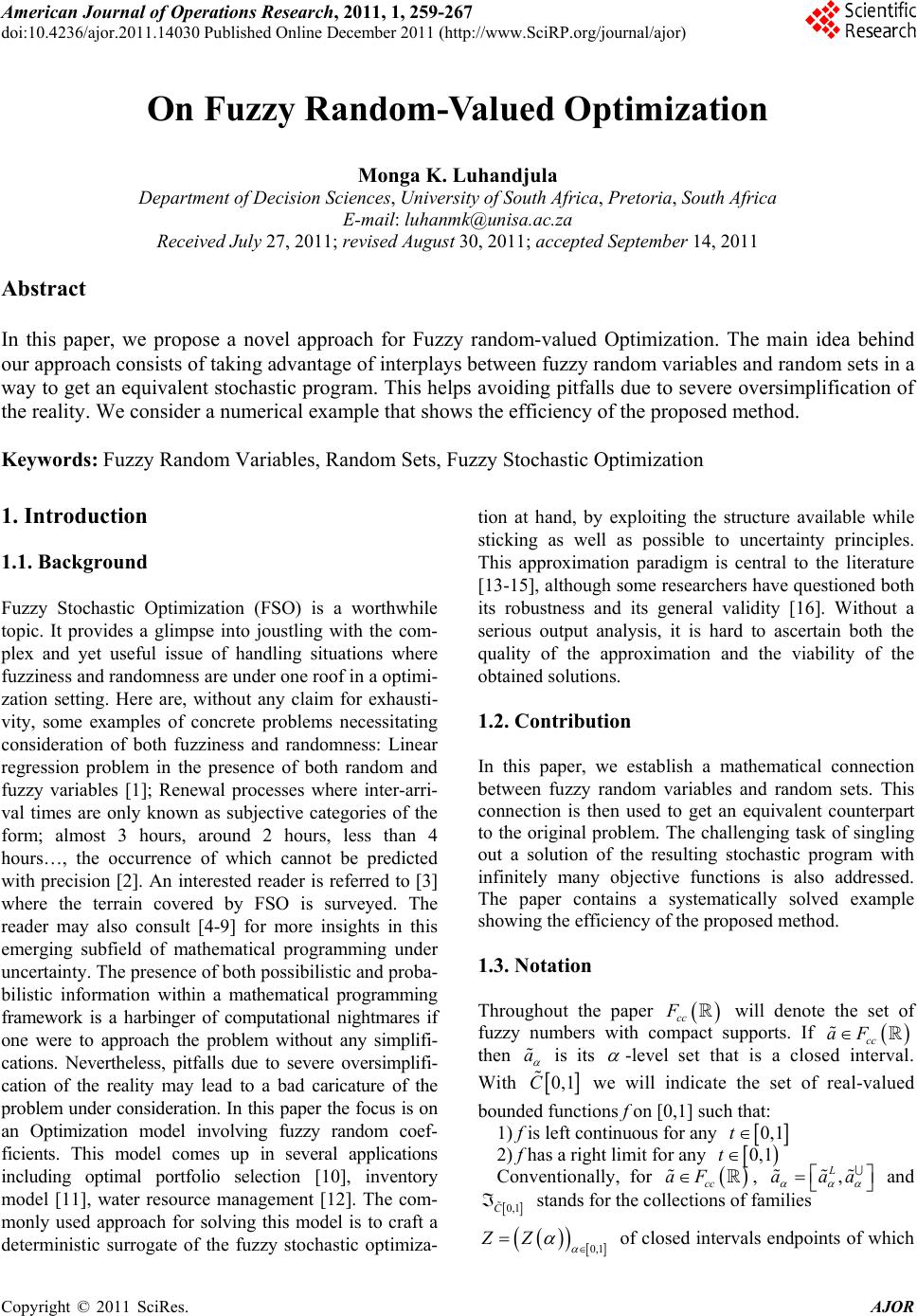 American Journal of Operations Research, 2011, 1, 259-267 doi:10.4236/ajor.2011.14030 Published Online December 2011 (http://www.SciRP.org/journal/ajor) Copyright © 2011 SciRes. AJOR 259 On Fuzzy Random-Valued Optimization Monga K. Luhandjula Department of Deci sio n Sci e n ces , Uni versit y of South Africa , Pretori a, South Africa E-mail: luhanmk@unisa.ac.za Received July 27, 201 1; revised August 30, 2011; accepted September 14, 2011 Abstract In this paper, we propose a novel approach for Fuzzy random-valued Optimization. The main idea behind our approach consists of taking advantage of interplays between fuzzy random variables and random sets in a way to get an equivalent stochastic program. This helps avoiding pitfalls due to severe oversimplification of the reality. We consider a numerical example that shows the efficiency of the proposed method. Keywords: Fuzzy Random Variables, Random Sets, Fuzzy Stochastic Optimization 1. Introduction 1.1. Background Fuzzy Stochastic Optimization (FSO) is a worthwhile topic. It provides a glimpse into joustling with the com- plex and yet useful issue of handling situations where fuzziness and randomness are under one roof in a optimi- zation setting. Here are, without any claim for exhausti- vity, some examples of concrete problems necessitating consideration of both fuzziness and randomness: Linear regression problem in the presence of both random and fuzzy variables [1]; Renewal processes where inter-arri- val times are only known as subjective categories of the form; almost 3 hours, around 2 hours, less than 4 hours…, the occurrence of which cannot be predicted with precision [2]. An interested reader is referred to [3] where the terrain covered by FSO is surveyed. The reader may also consult [4-9] for more insights in this emerging subfield of mathematical programming under uncertainty. The presence of both possibilistic and proba- bilistic information within a mathematical programming framework is a harbinger of computational nightmares if one were to approach the problem without any simplifi- cations. Nevertheless, pitfalls due to severe oversimplifi- cation of the reality may lead to a bad caricature of the problem under consideration. In this paper the focus is on an Optimization model involving fuzzy random coef- ficients. This model comes up in several applications including optimal portfolio selection [10], inventory model [11], water resource management [12]. The com- monly used approach for solving this model is to craft a deterministic surrogate of the fuzzy stochastic optimiza- tion at hand, by exploiting the structure available while sticking as well as possible to uncertainty principles. This approximation paradigm is central to the literature [13-15], although some researchers have questioned both its robustness and its general validity [16]. Without a serious output analysis, it is hard to ascertain both the quality of the approximation and the viability of the obtained solutions. 1.2. Contribution In this paper, we establish a mathematical connection between fuzzy random variables and random sets. This connection is then used to get an equivalent counterpart to the original problem. The challenging task of singling out a solution of the resulting stochastic program with infinitely many objective functions is also addressed. The paper contains a systematically solved example showing the efficiency of the proposed method. 1.3. Notation Throughout the paper will denote the set of fuzzy numbers with compact supports. If cc F cc aF then a is its -level set that is a closed interval. With 0,1C we will indicate the set of real-valued bounded f u nct ions f on [0,1] such that: 1) f is left continuous for any 0,1t 0,1 2) f has a right limit for any t Conventionally, for , and cc aF , L aaa 0,1C stands for the collections of families 0,1 ZZ of closed intervals endpoints of which 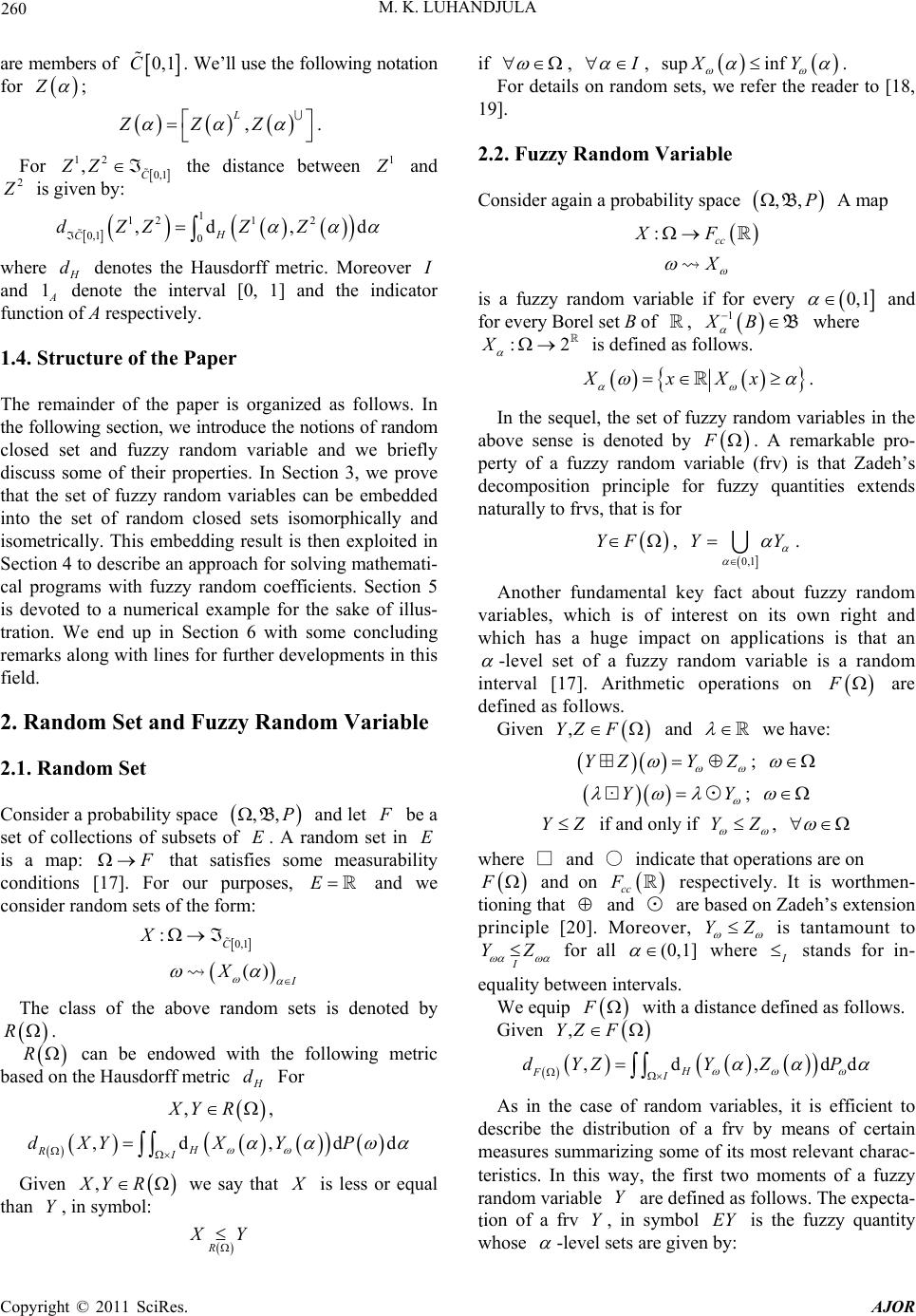 M. K. LUHANDJULA 260 are members of 0,1C . We’ll use the following notatio n for Z ; , L ZZZ . For the distance between 12 0,1 ,C ZZ1 and 2 is given by: 1 121 2 0,1 0 ,d , H C dZZ ZZd where d denotes the Hausdorff metric. Moreover and denote the interval [0, 1] and the indicator function of A respectively. 1A 1.4. Structure of the Paper The remainder of the paper is organized as follows. In the following section, we introduce the notions of random closed set and fuzzy random variable and we briefly discuss some of their properties. In Section 3, we prove that the set of fuzzy random variables can be embedded into the set of random closed sets isomorphically and isometrically. This embedding result is then exploited in Section 4 to describe an approach for solving mathemati- cal programs with fuzzy random coefficients. Section 5 is devoted to a numerical example for the sake of illus- tration. We end up in Section 6 with some concluding remarks along with lines for further developments in this field. 2. Random Set and Fuzzy Random Variable 2.1. Random Set Consider a probability space ,,PB and let be a set of collections of subsets of . A random set in is a map: E E that satisfies some measurability conditions [17]. For our purposes, and we consider random sets of the form: E 0,1 : () C X X The class of the above random sets is denoted by R. R can be endowed with the following metric based on the Haus do rff metric d For ,XY R, ,d R dXYY P ,d H IXd Given we say that ,XY R is less or equal than , in symbol: Y R Y if , , sup infXY . For details on random sets, we refer the reader to [18, 19]. 2.2. Fuzzy Random Variable Consider again a probability space A map ,,PB : cc XF X is a fuzzy random variable if for every 0,1 and for every Borel set B of , where is defined as follows. 1 XB B :2X XxXx . In the sequel, the set of fuzzy random variables in the above sense is denoted by . A remarkable pro- perty of a fuzzy random variable (frv) is that Zadeh’s decomposition principle for fuzzy quantities extends naturally to frvs, that is for F YF , 0,1 YY . Another fundamental key fact about fuzzy random variables, which is of interest on its own right and which has a huge impact on applications is that an -level set of a fuzzy random variable is a random interval [17]. Arithmetic operations on F are defined as follows. Given ,YZ F and we have: YZY Z ; YY ⊙; YZ if and only if YZ , where and ○ indicate that operations are on □ F and on cc F respectively. It is worthmen- tioning that and ⊙ are based on Zadeh’s extension principle [20]. Moreover, YZ is tantamount to IZY for all (0,1] where stands for in- equality between intervals. We equip F with a distance defined as follows. Given ,YZ F ,d,d H FI dYZY ZP d As in the case of random variables, it is efficient to describe the distribution of a frv by means of certain measures summarizing some of its most relevant charac- teristics. In this way, the first two moments of a fuzzy random variable are defined as follows. The expecta- tion of a frv , in symbol is the fuzzy quantity whose Y YEY -level sets are given by: Copyright © 2011 SciRes. AJOR  261 M. K. LUHANDJULA d is a selection of EYf P fY . The variance of Y, in symbol VY, is given by the following relation: , F VYEdY EY Limit theorems [22] have been obtained for frvs based on the above notions of expectation and variance. Moreover, fuzzy random variables enjoy the Random- Nikodým property [21 ]. That is, if :cc FF is a P-continuous fuzzy measure of bounded variation, then there is such that: YF d B BYP BB, 3. Embedding Theorem for Fuzzy Random Variables 3.1. Auxiliary Mappings The following three maps will play a staring role in the statement and the proof of an Embedding Theorem for fuzzy random variables. 3.1.1. Mapping maps into as follows. cc F 0,1C 0,1 : , cc C L F aa a where = L aa and =aa . It is well known (see e.g [23,24]) that thus defined is injective, isometric and satisfies the following relation: For and ,cc ab F ,st , , 0s0t 11 st absat ⊙⊙ b . 3.1.2. Mappin gs f and The two other auxiliary maps are given below. : cc fF F XX 0,1 : C F XX 3.1.3. Remark Relationships between auxiliary mappings are shown in Figure 1. The three auxiliary mappings make the dia- gram given in Figure 1 commutative. As a matter of fact, XX Figure 1. Diagram involving auxiliary functions. Therefore of . 3.2. Main mapping The mapping that is used in our Embedding Theorem for fuzzy random variables is defined as follows. : FR XX where 0,1 : , C L X XX and ,, LL XX XX Relationships between the main mapping and auxiliary mappings is given in Figure 2. Mappings involved in Fig- ure 2 make the diagram given in Figure 2 commut ati ve . As a matter of fact, For XXX Hence X . For the sake of convenience, we identify a real number a with the following degenerate fuzzy number. :0a ,1 with X Figure 2. Diagram involving the main mapping. Copyright © 2011 SciRes. AJOR  M. K. LUHANDJULA 262 1if 0otherwise. ta at Moreover, we denote by , the degenerate fuzzy random variable: 1AA 1: 1 Acc A A Building on the mappings , , , and on the above terminological conventions, we are now ready to present the main result of this section . 3.3. Statemen t and Pr oof o f the Embed ding Theorem 3.3.1. Theorem 1 Consider ; ,XY F , , 0 , 0 and let be as in §3.2. Then the following statements hold true. 1) is injective 2) 11= YX Y 3) ,, FR dXYd XY 4) R YXY In other terms maps F into isomor- phically and isometrically. R Moreover, is order preserving. 3.3.2. Proof of Theorem 1 1) Let and assume ,XY F Y Then for we have that: XY ; Y . This means that for we have: XX fYY As is injective, we conclude that Y for all . Therefore Y and we are done. 2) 11 11 11 11 11 XY XY fXY XY XY 11 . XY YX XYXY ⊙⊙ Y Therefore 11 YX Y as desired. 3) d, d,d d,d d,d R H I H I H I XY XYP XYP XYP d d d. As is isometric we have that: d,d,d d d,. H I R F XYX YP XY 4) Y if and only if Y , . This is tantamount to say that: Y if and only if Y , (1) As L X and L YY , we have that (1) can be written: if and only if ,, , LL XY XX YY (2) (2) is equivalent to Y if and only if Y if and only if XY , (3) But XY , is equivalent to sup infXY , or R Y . Therefore (3) can be written: Y if and only if R Y and we are done. 4. Solving Fuzzy Random-Valued Optimization Problems 4.1. Case of Deterministic Feasible Set Here we are interested in solving the following Optimi- zation problem: Copyright © 2011 SciRes. AJOR 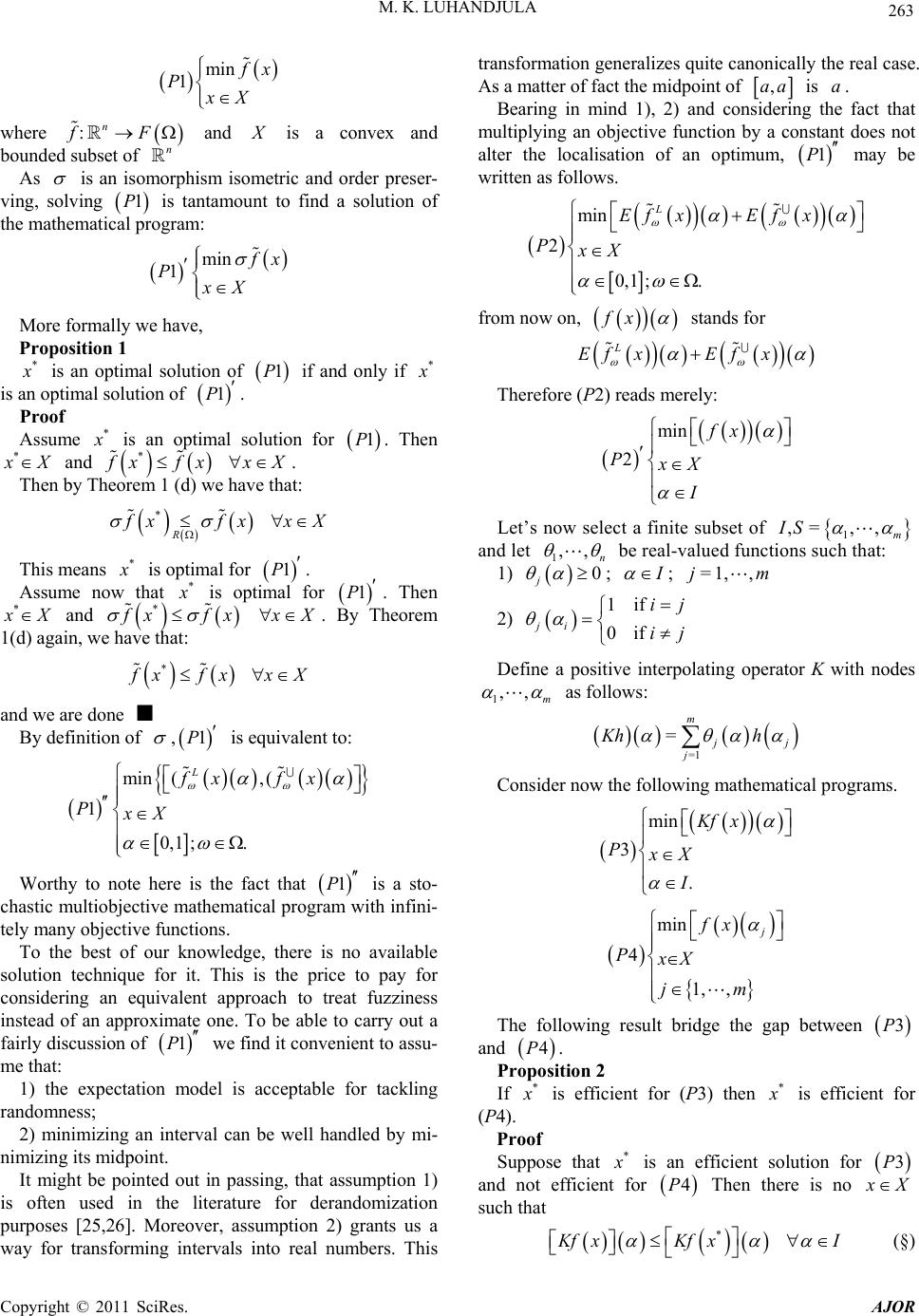 263 M. K. LUHANDJULA min 1 x PxX where and :n fF is a convex and bounded subset of n As is an isomorphism isometric and order preser- ving, solving 1P is tantamount to find a solution of the mathematical program: min 1 x PxX More form ally we have, Propositi on 1 * is an optimal solution of 1P if and only if * is an optimal solution of 1P . Proof Assume * is an optimal solution for 1P. Then * X and * xfx X . Then by Theorem 1 (d) we have that: * R xf x X This means * is optimal for . 1P Assume now that * is optimal for 1P . Then * X and * xf x X . By Theorem 1(d) again, we have that: * xfx X and we are done By definition of , is equivalent to: 1P L min (,( 1 0,1 ;. fx fx PxX Worthy to note here is the fact that is a sto- chastic multiobjective mathematical program with infini- tely many objective functions. 1P To the best of our knowledge, there is no available solution technique for it. This is the price to pay for considering an equivalent approach to treat fuzziness instead of an approximate one. To be able to carry out a fairly discussion of we find it convenient to assu- me that: 1P 1) the expectation model is acceptable for tackling randomness; 2) minimizing an interval can be well handled by mi- nimizing its midpoint. It might be pointed out in passing, that assumption 1) is often used in the literature for derandomization purposes [25,26]. Moreover, assumption 2) grants us a way for transforming intervals into real numbers. This transformation generalizes quite canonically the real case. As a matter of fact the midpoint of ,aa is . a Bearing in mind 1), 2) and considering the fact that multiplying an objective function by a constant does not alter the localisation of an optimum, 1P may be written as follows. min 2 0,1 ;. L Ef xEf x PxX from now on, fx stands for Ef xEf x L Therefore (P2) reads merely: min 2 fx PxX I Let’s now select a finite subset of 1 ,=, ,m IS and let 1,, n be real-valued functions such that: 1) 0 j; ; =1, ,jm 2) 1if 0if ji ij ij Define a positive interpolating operator K with nodes 1,, m as follows: =1 =m j j Kh h Consider now the following mathematical programs. min 3 . Kf x PxX I min 4 1, , j fx PxX jm The following result bridge the gap between 3P and 4P. Propositi on 2 If * is efficient for (P3) then * is efficient for (P4). Proof Suppose that * is an efficient solution for 3P and not efficient for 4P Then there is no X such that * Kf xKf x (§) Copyright © 2011 SciRes. AJOR  M. K. LUHANDJULA 264 and * <Kf xKf x for some (§§) As * is not efficient for 4 we have that, P also there is X such that * j fx fx 1,,m j and * < s x fxf for some 1, , m. Consider now jj arben. As and at: itrarily chos we have th 0 j =1 * jj fx 0 j fx 1,j, m and for some *<0 sss fxfx 1,, m Therefore we can say that there is X such that: This means, as * =1 <0 jj fx fx m j j has been chosen arbitra, that there is rily X such that: * <Kf xKf x This contradicts the fact that there is no X such that (§) and (§§) hold. Therefore * is efficient for (P4). It is a common place to say that (P3) is the same as P 2 where x is replaced by fx Unfortuna- n be efficient for (P tel mathe y both 2P and (P3) are too cumbersome for matical tractability. For practical purposes, we’ll resort to (P4)is a discretization of 2P Thanks to the contraposite of Proposition 2, we know that only an efficient solution of (P4) ca that 3). It might also be pointed out in passing that the discretization error decreases when the grid 1,, m S is refined [30]. This means we should keep the roughness of the grid, i.e. 11 ,, maxmin mi hh im I as low as possible. The foregoing discussion leads us to describe the for solving following algorithm 1P. Description of the algorithm Step 0: Fix0 an acceptablend bou of error for e (P h. Step 1: Read data of (P1). Step 2: Fram1) as 2P. Step 3: Put 0 . Step 4: Take a discretiz ofation e (P4) r (P4). 1 ,,, m IS . Step 5: Writ. Step 6: Find an efficient solution fo Step 7: Compute 1 max min im i h and ch- ec k whether <h . If this is true, go t Otherwise o Step 9, go to Step 8. tization , put Step 8: Take a finer discreSSS an 4.zy Random Constraints ation pro- lem. d go to Step 5. Step 9: Print the solution obtained. Step 10: Stop. 2. Case of Fuz Here we are interested in the following optimiz b 5;= 1, , ii P min fx xbi m ,,=1,, i gi m n and where are fuzzy random func- tions of-valued i bF ; ider the followin=1, ,im. Consg optimization problem: min 6;=1, , fx P ii R xbim Before stating a result that bridges the ga between p 5P and 6P, we introduce the following respective surrogates to 5P and 6P respectively. 5fx P min xX min 6fx PxX and where are deterministic counterparts of the following sets respectively: ;=1, , nii gx bim and ;=1, , nii R gxbi m Propositi on 3 is an optimal solution for if and only if 5P * * is optimal for 6P . Proof By Theorem 1 (de ha X ), wve that Moreover byition 1, Propos 5P and valent. 6P are equi (P5) anIn this sense, we can say that d (P6) are Copyright © 2011 SciRes. AJOR 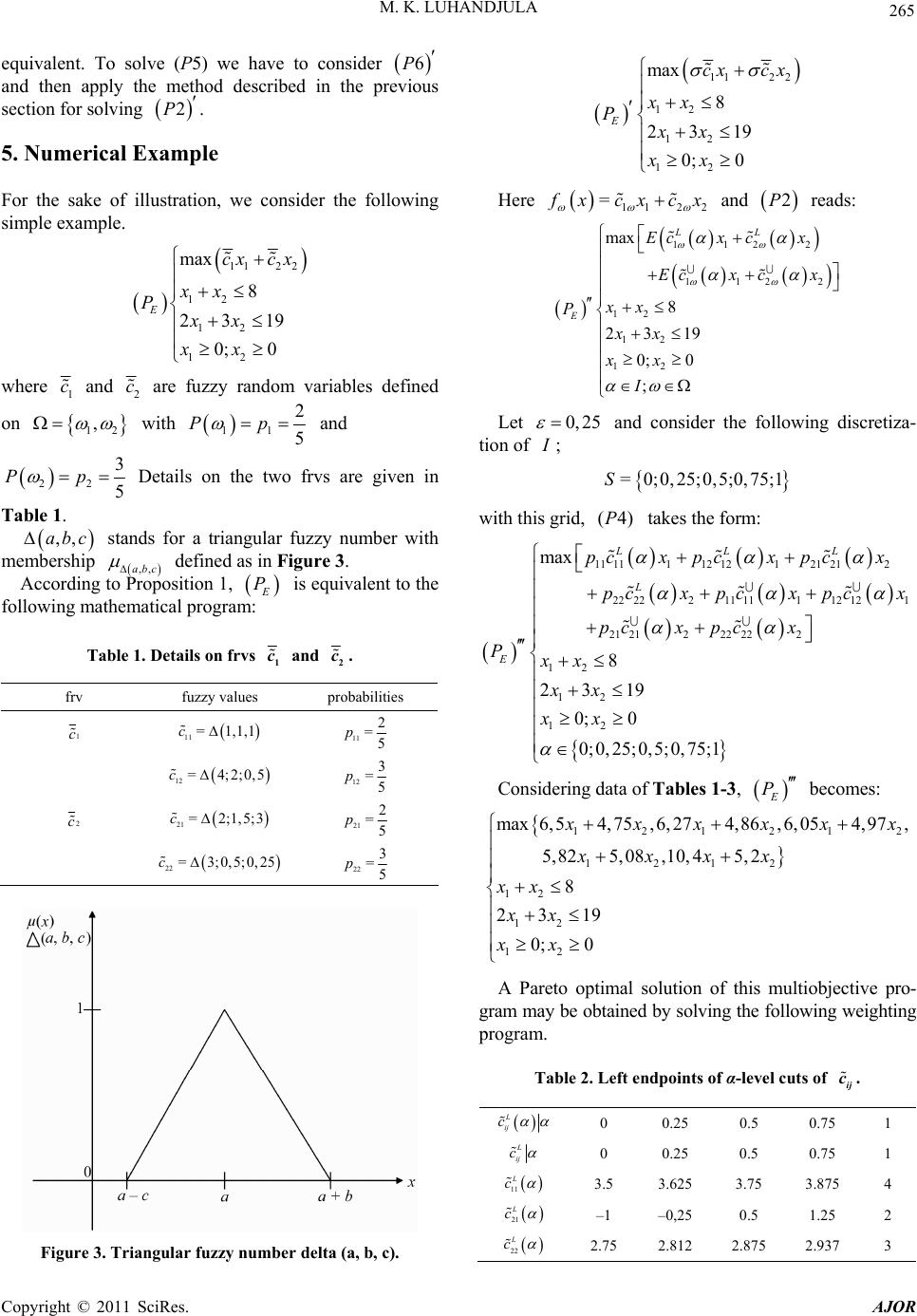 M. K. LUHANDJULA 265 lve (Phaveequivalent. To so5) we to consider P 6 an amp we consider the following mple example. d then apply the method described in the previous section for solving 2P. 5. Numerical Exle For the sake of illustration, si max cx cx 112 2 12 12 12 8 2319 0; 0 Exx Pxx xx where 1 c and 2 c are fuzzy random variables defined on 12 , with 11 5 Pp 2 and 22 3 5 Pp Detailsrvs are on the two fgiven in Table 1. ,,abc stands for a triangular fuzzy number with membership ,,abc defined as in Figure 3. According to Proposition 1, P is equivalent to the following macal program: themati Table 1. Details on frvs 1 c and 2 c. frv fuzzy values probabilities 1 c 11 = 1,1,1c 11 =5 p 2 12 =4;2;0,5c 12 3 =5 p 2 c 21 =2;1,5;3c 21 2 =5 p 22 =3;0,5;0,25c 22 3 =5 p 1122 12 12 12 max 8 2319 0; 0 E cx cx xx Pxx xx 1122 = xcxcx and reads: 2PHere 1122 112 2 12 12 12 max 8 2319 0; 0 LL E Ecx cx Ecx cx xx P xx xx ;I Let 0,25 and consider the following discretiza- tion of ; = 0;0,25;0,5;0,75;1S with this grid, takes the form: iderig d (4)P 11 1111212 2222211 11112 121 21 21222222 12 12 12 max 8 2319 0; 0 0;0,25;0,5;0,75;1 L L E pcxpx pcxpcx pcx pcxpcx Pxx xx xx 1221 21 LL cpc x Consnata of Tables 1-3, E P becomes: 12121 1212 12 12 12 max 6,54,75,6,274,054,97, 5,825,08,10,45,2 2319 0; 0 86 ,6, Figure 3. Triangular fuzzy number delta (a, b, c). 2 8 xx x xxxx xx xx x x A Pareto optimal solution of this multiobjective pro- gram may be obtained by solving the following weighting program. Table 2. Left endpoints of α-level cuts of xx ij c. L ij c 0 0.25 0.5 0.75 1 L ij c 0 0.25 0.0.75 1 5 11 L c 3.5 3.625 3.75 3.875 4 21 L c –1 –0,25 0.5 1.25 2 22 L c 2.75 2.812 2.875 2.937 3 Copyright © 2011 SciRes. AJOR 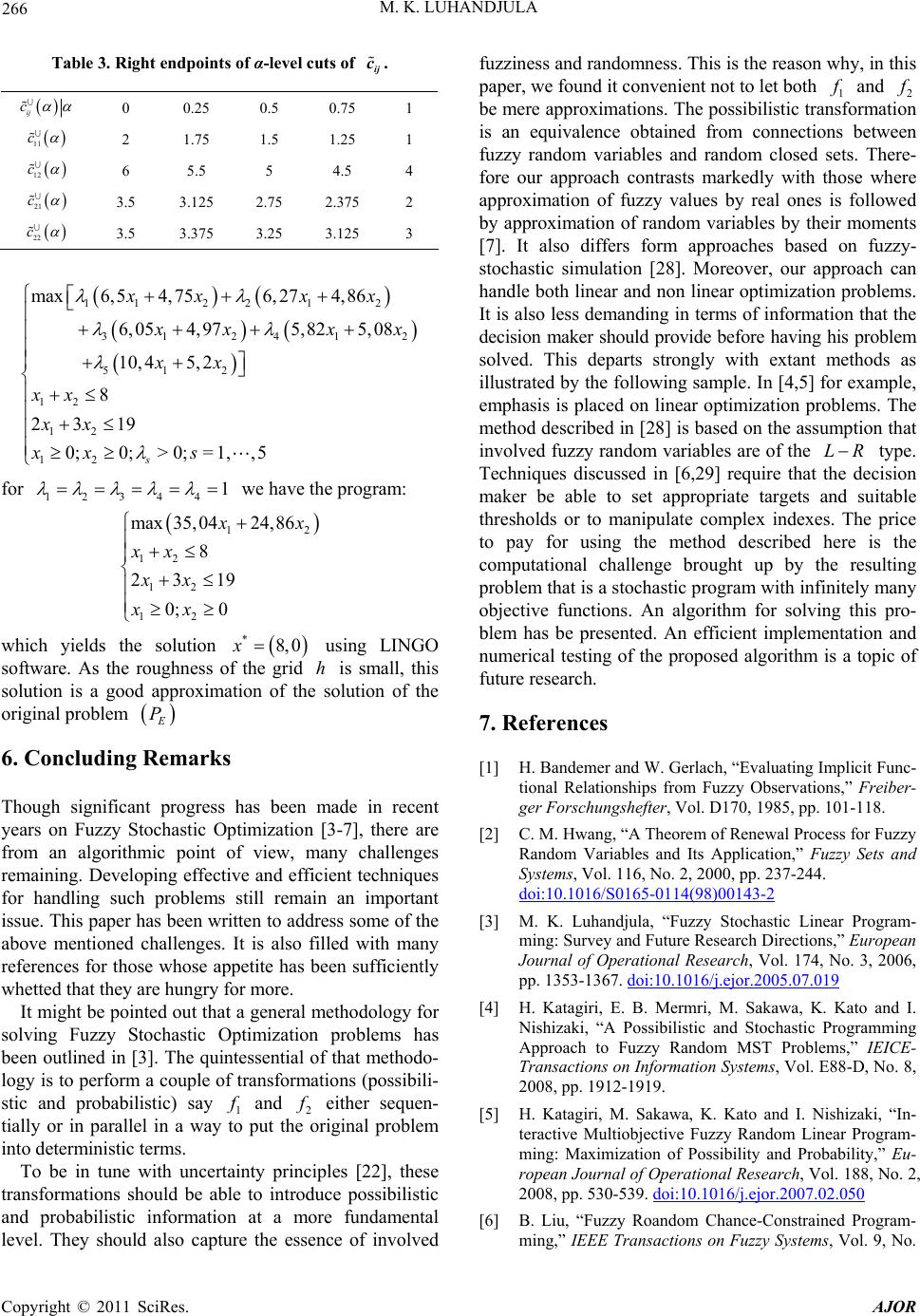 M. K. LUHANDJULA 266 Table 3. Right endpoints of α-level cuts of ij c. ij c 0 0.25 0.5 0.75 1 11 c 2 1.75 1.5 1.25 1 12 c 6 5.5 5 4.5 4 21 c 3.5 3.125 2.75 2.375 2 22 c 3.5 3.375 3.25 3.125 3 1122 12 31 241 512 12 12 12 max6,5 4,756,274,86 5,0 ,4 8 23 > 0,,5 s xx xx 2 6,054,975,828 105,2 19 0;0;;=1 xx x for x xx xx xx x s 1243 4 1 we have thrame prog: 12 max35,0424,86 12 12 12 19 0; 0 8 23 x x x xx xx which yields the solution LINGO softwareth ughall, this solution is a good approximn ohe riginal problem 8, *0x the grid atio the using is sm. As e roness ofh n of solutiof t o P 6. Concluding Remarks Though significant progress has been made in recent years on Fuzzy Stochastic Optimization [3-7], there ae from an algorithmic point of view, many challenges remaining. Developing effective and efficient techniques for handling such problems still remain an important issue. This paper has been written to address some of the e mentioned challenges. It references for those whose appetite has been sufficiently whetted that they are hungry for more. It might be pointed out that a general mthodology for solving Fuzzy Stochastic Optimization problems has been outlined in [3]. The quintessential of that methodo- logy is to perform a couple of transformations (possibili- r abov is also filled with many e stic and probabilistic) say 1 and 2 either sequen- tially or in parallel in a way to put the original problem into deterministic terms. To be in tune uwith ncertainty principles [22], these troduce possibilistic at a more fundam vel. They should also capture the essence of invo transformations should be able to in and probabilistic information ental lved le fuzziness and randomness. This is the reason why, in this paper, we found it co nv enient not to let both 1 and 2 be mere approximations. The possibilistic transformation is an equivalence obtained from connections between fuzzy random variables and random closed sets. There- fore our approach contrasts markedly with those where approximation of fuzzy values by real ones is followed by approximation of random variables by their moments [7]. It also differs form approaches base fu sto y ear optimization problems m d onzzy- . The chastic simulation [28]. Moreover, our approach can handle both linear and non linear optimization problems. It is also less demanding in terms of information that the decision maker should provide before having his problem solved. This departs stronglwith extant methods as illustrated by the following sample. In [4,5] for example, emphasis is placed on lin ethod described in [28] is based on the assumption that involved fuzzy random variables are of the LR type. Techniques discussed in [6,29] require that the decision maker be able to set appropriate targets and suitable thresholds or to manipulate complex indexes. The price to pay for using the method described here is t computational challenge brought up by the resulting problem that is a stochastic program with infinitely many objective functions. An algorithm for solving this pro- blem has be presented. An efficient implementation and numerical testing of the proposed algorithm is a topic of future research. 7. References [1] H. Bandemer and W. Gerlach, “Evaluating Implicit Func- tional Relationships from Fuzzy Observations,” Freiber- ger Forschungshefter, Vol. D170, 1985, pp. 101-118. [2] C. M. Hwang, “A Theorem of Renewal Process for Fuzzy Random Variables and Its Application,” Fuzzy Sets and Systems, Vol. 116, No. 2, 2000, pp. 237-244. doi:10.1016/S0165-0114(98)00143-2 he [3] M. K. Luhandjula, “Fuzzy Stochastic Linear Program- ming: Survey and Future Research Directions,” European Journal of Operational Research, Vol. 174, No. 3, 2006, pp. 1353-1367. doi:10.1016/j.ejor.2005.07.019 [4] H. Katagiri, E. B. Mermri, M. Sakawa, K. Kato and I. Nishizaki, “A Possibilistic and Stochastic Programming Approach to Fuzzy Random MST Problems,” IEICE- Transactions on Information Systems, Vol. E88-D, No. 8, 2008, pp. 1912-1919. [5] H. Katagiri, M. Sakawa, K. Kato and I. Nishizaki, “In- teractive Multiobjective Fuzzy Random Linear Program- ming: Maximization of Possibility and Probability,” Eu- l of Operational Research, Vol. 188, No. 2, 539. doi:10.1016/j.ejor.2007.02.050 ropean Journa 2008, pp. 530- [6] B. Liu, “Fuzzy Roandom Chance-Constrained Program- ming,” IEEE Transactions on Fuzzy Systems, Vol. 9, No. Copyright © 2011 SciRes. AJOR  M. K. LUHANDJULA Copyright © 2011 SciRes. AJOR 267 5, 2001, pp. 713-720. doi:10.1109/91.963757 [7] Y. K. Liu and B. Liu, “A Class of Fuzzy Random Opti- mization: Expected Value Models,” Information Sciences, Vol. 155, No. 1-2, 2002, pp. 89-102. doi:10.1016/S0020-0255(03)00079-3 [8] Y. K. Liu and B. Liu, “Fuzzy Random Programming with Equilibrium Chance Constraints,” Information Sciences, Vol. 170, No. 2-4, 2005, pp. 363-395. doi:10.1016/j.ins.2004.03.010 [9] E. E. Ammar, “On Fuzzy Random Multiobjective Quad- ratic Programming,” European Journal of Operational Research, Vol. 193, No. 2, 2009, pp. 329-341. doi:10.1016/j.ejor.2007.11.031 [10] Z. Zmeskel, “Value at Risk Methodology under Soft Conditions Approach (Fuzzy-Stochastic Approach),” Eu- ropean Journal of Operational Research, Vol. 161, No. 2, 2005, pp. 337-347. doi:10.1016/j.ejor.2003.08.048 [11] P. Dutta, D. Chakraborty and A. R. Roy, “A Single-Pe- riod Inventory Model with Fuzzy Random Variable De- mand,” Mathematical and Computer Modelling, Vol. 41, No. 8-9, 2005, pp. 915-922. doi:10.1016/j.mcm.2004.08.007 [12] F. Ben Abdelaziz, L. Enneifar and J. M. Martel, “A Mul- tiobjective Fuzzy Stochastic Program for Water Resource Optimization: The Case of Lake Management,” 2 005. http://www.sharjah.ac.ae/academi/ [13] M. K. Luhandjula, “Optimization under Hybrid Uncer- tainty,” Fuzzy Sets and Systems, Vol. 146, No. 2, 2004, pp. 187-203. doi:10.1016/j.fss.2004.01.002 [14] C. Mohan and H. T. Nguyen, “An Interactive Satisfying Method for Solving Multiobjective Mixed Fuzzy Sto- chastic Programming Problems,” Fuzzy Sets and Systems, Vol. 117, No. 1, 2001, pp. 61-79. doi:10.1016/S0165-0114(98)00269-3 [15] S. Nanda, G. Panda and J. Dash, “A New Solution Method for Fuzzy Chance Constrained Programming Problem,” Fuzzy Optimization and Decision Making, Vol. 5, No. 4, 2006, pp. 355-370. doi:10.1007/s10700-006-0018-8 [16] W. M. Kirby, “Paradigm Change in Operations Research: Thirty Years of Debate,” Operations Research, Vol. 55, No. 1, 2008, pp. 1-13. doi:10.1287/opre.1060.0310 [17] R. Kruze and K. D. Meyer, “Statistics with Vague Data,” Reidel, Dordrecht, 1987. doi:10.1007/978-94-009-3943-1 [18] I. Moklanov, “Theory of Random Sets,” Springer, New Sets and Systems: The- Press, New York, 1980. 383- York, 2005. [19] G. Matheron, “Random Sets and Integral Geometry,” John Wiley & Sons, New York, 1975. [20] D. Dubois and H. Prade, “Fuzzy ory and Applications,” Academic [21] J. Bán, “Radon-Nikodyým Theorem and Conditional Expectation of Fuzzy-Valued Measures and Variables,” Fuzzy Sets and Systems, Vol. 34, No. 3, 1990, pp. 392. doi:10.1016/0165-0114(90)90223-S [22] E. P. Klement, M. L. Puri and D. A. Ralescu, “Limit Theorems for Fuzzy Random Variables,” Proceedings of the Royal Society A, Vol. 407, No. 1832, 1986, pp. 171- 182. doi:10.1098/rspa.1986.0091 [23] C. X. Wu and M. Ma, “Embedding Problem of Fuzzy Number Space,” Fuzzy Sets and Systems, Vol. 44, No. 1, 1991, pp. 33-38. doi:10.1016/0165-0114(91)90030-T [24] H. C. Wu, “Evaluate Fuz zy Opt imiz at io n Problems Ba sed on Biobjective Programming Problems,” Computer and Mathematics with Applications, Vol. 47, No. 6-7, 2004, pp. 893-902. doi:10.1016/S0898-1221(04)90073-9 [25] P. Kall, “Stochastic Linear Programming,” Springer, New York. doi:10.1007/978-3-642-66252-2 [26] S. Vajda, “Probabilistic Programming,” Academic Press, New York, 1972. [27] G. J. Klir, “Principles of Uncertainty: What Are They? Why Do We Need Them?” Fuzzy Sets and Systems, Vol. 74, No. 1, 1995, pp. 13-31. doi:10.1016/0165-0114(95)00032-G [28] J. Li, J. Xu and M. Gen, “A Class of Multiobjective Lin- ear Programming Model with Fuzzy Random Coeffi- cients,” Mathematical and Computer Modelling, Vol. 44, No. 11-12, 2008, pp. 1097-1113. doi:10.1016/j.mcm.2006.03.013 [29] V. H. Nguyen, “Solving Linear Programming Problems under Fuzziness and Randomness Environment Using Attainment Values,” Information Sciences, Vol. 177, No. 14, 2007, pp. 2971-2984. doi:10.1016/j.ins.2007.01.032 [30] K. Glashoff and S. A. Gustafson, “Linear Optimization and Approximation,” Springer-Verlag, Berlin, 1983. doi:10.1007/978-1-4612-1142-6
|